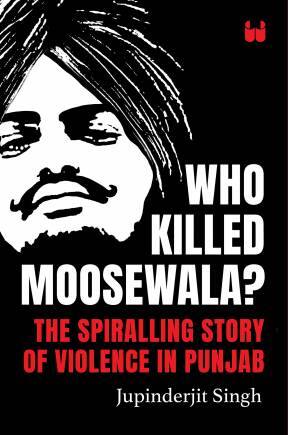Sidhu Moosewala was shot to death by multiple assailants as he was riding in his Thar to his aunt’s village in Punjab on May 29, 2022. (Image via Instagram)
About a year ago, in June 2022, Sidhu Moosewala’s posthumous single ‘SYL’ (alluding to the Satluj-Yamuna Link canal) soared to no. 3 in the Indian charts and entered the top 100 in Canada and Australia as well. It was confirmation of the fact that India had just lost one of its most influential young artists. On May 29, 2022, the 28-year-old Moosewala was shot to death by multiple assailants as he was riding in his Thar to his aunt’s village in Punjab. A few days before the fatal shooting, the newly-elected Aam Aadmi Party government had reduced the singer’s security cover. A political storm brewed while the police forces of both Delhi and Punjab hunted for the assassins.
 Who Killed Moosewala book cover
Who Killed Moosewala book cover
Journalist Jupinderjit Singh’s Who Killed Moosewala: The Spiralling Story of Violence in Punjab (released last week by Westland Books) is a timely, well-rounded book that introduces us to this remarkable young man and tells us the story behind his shocking death. Singh, a crime journalist working for The Tribune in Punjab, brings his beat’s characteristic energy and attention to detail to the table.
The first half of the book is a conventionally structured true crime narrative — the criminal plot itself, the conspirators, their back stories, how they came to know the mastermind (the gangster Lawrence Bishnoi) and so on. The second half is where Who Killed Moosewala blossoms to become a more ambitious book — a wide-ranging socio-political study of a society waylaid by drugs, machismo culture and gang-driven violence. Towards the end, there’s also a lovely chapter in which Singh briefly hits pause on the crime narrative, and instead opts for a close reading of Moosewala’s lyrics. Here’s an artist who was clearly evolving, from a brash young man singing about destroying his enemies to a budding rebel-philosopher, railing against religious and societal orthodoxies.
In the mini-profiles of the assassins, Singh takes pains to connect each of their stories to a specific issue in the fabric of Punjabi society. For example, one of the killers, Mannu Kusa, came from a Dalit Sikh family which was being relentlessly bullied and harassed by a powerful Jat man and his friends. Kusa’s sister was being hounded, the police sided with the Jats and nothing helped until Kusa, with the help of his newfound gangster friends, chose violence. Singh doesn’t pull his punches while critiquing this blatant caste-based discrimination and abuse.
“In the Jat land, Dalits are treated like paon ki jutti, slippers, with no great value. Discrimination, while illegal, inhumane and unlawful as per the Constitution of India, is deeply entrenched. Mannu Kusa’s family converted to Sikhism with the belief that their lot in society would improve. Sikhism views all humans as of one caste and from one seed. But the reality that they were facing now was very different. Not only did the assailants beat up Mannu, they also circulated the video on social media as a lesson and warning for others.”
Similarly, another assassin, Ankit Sersa, is hopelessly addicted to ‘chitta’, a white-powdered opiate and heroin alternative popular in Punjab. Singh deftly weaves Sersa’s story with the chitta epidemic at large, showing us patterns that speak to the very origins of criminality. All of these gun-toting men that we meet during the course of Who Killed Moosewala have one thing in common — in philosophical terms, they represent a ‘crisis of masculinity’. Lawrence Bishnoi, the mastermind of the murder and one of the most infamous gangsters in North India, is himself a prime example of this. See how carefully Singh describes his wrestler’s lifestyle and ‘brahmachari’ attire—he often wore just the wrestler’s langot.
“His biceps and triceps, deltoids, trapezius and dorsal muscles appear well-defined over a broad wrestler’s chest. He follows a strict free-weight exercise regimen besides working out with bodyweights in the akhara. The dossiers say Lawrence is a Brahmachari who mostly wears a langot and spends up to eight hours in dhyan or meditation. Sometimes, it was said, he would sit in meditation in his cell in Tihar Jail at midnight and get up well past sunrise.”
As several anthropologists (like Joseph Alter, for example) have noted, a lot of north Indian akhara traditions are about ‘self-discipline’ through denying the body.
This portrait of ‘self-discipline’ and the idea of Bishnoi being a brahmachari — i.e., celibate — can be readily contrasted with one of his accomplices, Priyavrat Fauji, who Singh tells us, was known to “indulge in the pleasures of the flesh” (an uncharacteristically coy description by this book’s standards). Fauji was seeing four women at the same time because of his allegedly insatiable appetite in this context. By the end of the book, you realize that Bishnoi and Fauji are the extremities of a crisis-of-masculinity spectrum, wherein directionless young men feel compelled to pursue an extremely narrow idea of ‘mardaangi’.
In fact, this is precisely where Moosewala was beginning to evolve in real earnest, his lyrics and his music presenting a very different model of masculinity from his early videos. And who knows where his artistic journey would have taken him? Who Killed Moosewala could have been content with breaking down its subject’s death. Instead, it succeeds in presenting a clear-eyed, sober deconstruction of Sidhu Moosewala’s life.
Who Killed Moosewala by Jupinderjit Singh; Westland Books; Rs 499; 200 pages.